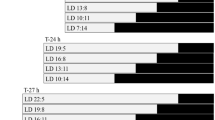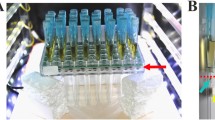Summary
The ‘external coincidence’ model for the photoperiodic clock, in its original form (e.g. Pittendrigh 1966), fails to account for the entireshape of the photoperiodic response curve in an insect such asSarcophaga argyrostoma (see Fig. 1) because it predicts as much diapause in ‘ultra-short’ daylengths (and in continuous darkness) as it does in ‘strong’ short daylengths closer to the critical photoperiod. This paper suggests, however, that a multioscillator version of external coincidence can explain the lowered incidence of pupal diapause in photoperiods of less than about 9 h, and therefore implies that external coincidence should not be rejected on this account alone.
-
1.
Using trains of 4 h light pulses (LD 4∶20, 240 uW cm−2) with the first pulse commencing at all phases or circadian times, the incidence of diapause was shown to be negatively correlated with the number of non-steady-state or transient cycles before entrainment is achieved. Furthermore, trains of ‘weak’ pulses (1 to 8 h) gave a higher incidence of diapause when commencing at Ct 12 (the end of the subjective day) than at Ct 24 (the beginning of the subjective day), although trains of ‘stronger’ pulses (10 to 21 h) showed no such difference.
-
2.
Increasing the irradiance of light pulses from 240 μW cm−2 to 16,000 μW cm−2 significantly increased diapause induction with 2 and 4 h pulses, but less so with pulses of 8 and 12 h duration.
-
3.
These results are consistent with a ‘multioscillator’ photoperiodic clock inS. argyrostoma (see also Saunders 1978). Night-length measurement by such a clock is assumed to be more effective when the circadian system isat steady state with the driving light cycle. Thus, ‘weak’ light pulses starting initially far from the steady state phase relationship cause the circadian system to pass through a series of transients before entrainment, and result in a lowered diapause incidence because an insufficient number of effective (steady state) long nights are accumulated before the end of the larval sensitive period. Raising the intensity of these shorter pulses increases their ‘strength’, probably lowers the number of transients, and increases the incidence of pupal diapause. The reduced effectiveness of night-length measurement during transient cycles might be caused by an incoherence among the oscillators comprising the clock. These results, however, do nothing to distinguish ‘ external coincidence ’ from the various forms of ‘internal coincidence’, but a multioscillator version of the former remains a valid type of model forS. argyrostoma.
-
4.
It is probable that insect species with a high sensitivity to light (i.e. a transition from Winfree's Type 1 to Type 0 resetting with short pulse durations) show a photoperiodic response curve (PPRC) in which ultra-short photoperiods (∼1 h) are strongly inductive, whereas those (likeS. argyrostoma) in which Type 1-Type 0 transitions occur with longer pulse durations show a ‘bell-shaped’ PPRC.
Similar content being viewed by others
References
Beck SD (1962) Photoperiodic induction of diapause in an insect. Biol Bull Mar Biol Lab (Woods Hole) 122:1–12
Bell RA, Rasul CG, Joachim FG (1975) Photoperiodic induction of the pupal diapause in the tobacco hornworm,Manduca sexta, J Insect Physiol 21:1471–1480
Chandrashekeran MK, Engelmann W (1976) Amplitude attenuation of the circadian rhythm inDrosophila with light pulses of varying irradiance and duration. Int J Chronobiol 3:231–240
Danilevskii AS (1965) Photoperiodism and seasonal development of insects, 1st English ed. Oliver and Boyd, Edinburgh
Denlinger DL (1971) Embryonic determination of pupal diapause in the flesh flySarcophaga crassipalpis. J Insect Physiol 17:1815–1822
Denlinger DL (1972) Induction and termination of pupal diapause inSarcophaga (Diptera: Sarcophagidae). Biol Bull Mar Biol Lab (Woods Hole) 142:11–24
Denlinger DL, Wingard P (1978) Cyclic GMP breaks pupal diapause in the flesh flySarcophaga crassipalpis. J Insect Physiol 14:689–705
Fraenkel G, Hsiao C (1968) Manifestations of a pupal diapause in two species of flies,Sarcophaga argyrostoma andS. bullata. J Insect Physiol 14:689–705
Johnsson A, Karlsson HG (1972) TheDrosophila eclosion rhythm, the transformation method, and the fixed point theorem. Department of Electrical Measurements, Lund Institute of Technology, Report No. 2/1972, November 15, 1972
Pittendrigh CS (1965) On the mechanism of entrainment of a circadian rhythm by light cycles. In: Aschoff J (ed) Circadian clocks. Amsterdam, North-Holland, pp 277–297
Pittendrigh CS (1966) The circadian oscillation inDrosophila pseudoobscura pupae: a model for the photoperiodic clock. Z Pflanzenphysiol 54:275–307
Pittendrigh CS (1972) Circadian surfaces and the diversity of possible roles of circadian organization in photoperiodic induction. Proc Natl Acad Sci USA 69:2734–2737
Pittendrigh CS (1981a) Circadian organization and the photoperiodic phenomena. In: Follett BK, Follett DE (eds) Biological clocks in seasonal reproductive cycles. Wright, Bristol, pp 1–35
Pittendrigh CS (1981b) Circadian systems: General perspectives. In: Aschoff J (ed) Handbook of behavioral neurobiology, vol 4, Biological rhythms. New York London, Plenum Press, pp 57–80
Pittendrigh CS, Daan S (1976) A functional analysis of circadian pacemakers in nocturnal rodents. V. Pacemaker structure: a clock for all seasons. J Comp Physiol 106:333–355
Pittendrigh CS, Minis DH (1964) The entrainment of circadian oscillations by light and their role as photoperiodic clocks. Am Nat 98:261–294
Pittendrigh CS, Minis DH (1971) The photoperiodic time measurement inPectinophora gossypiella and its relation to the circadian system in that species. In: Menaker M (ed) Biochronometry. National Academy of Sciences, Washington, pp 212–250
Pittendrigh CS, Bruce VG, Kaus P (1958) On the significance of transients in daily rhythms. Proc Natl Acad Sci USA 44:965–973
Saunders DS (1971) The temperature-compensated photoperiodic clock “programming” development and pupal diapause in the flesh-fly,Sarcophaga argyrostoma. J Insect Physiol 17:801–812
Saunders DS (1973) The photoperiodic clock in the flesh-flySarcophaga argyrostoma. J Insect Physiol 19:1941–1954
Saunders DS (1975) “Skeleton” photoperiods and the control of diapause in the flesh-fly,Sarcophaga argyrostoma. J Comp Physiol 97:97–112
Saunders DS (1976a) The circadian eclosion rhythm inSarcophaga argyrostoma: some comparisons with the photoperiodic clock. J Comp Physiol 110:111–133
Saunders DS (1976b) Insect clocks. Oxford, Pergamon Press
Saunders DS (1978) An experimental and theoretical analysis of photoperiodic induction in the flesh-fly,Sarcophaga argyrostoma. J Comp Physiol 124:75–95
Saunders DS (1979) External coincidence and the photoinducible phase in theSarcophaga photoperiodic clock. J Comp Physiol 132:179–189
Saunders DS (1980) Some effects of constant temperature and photoperiod on the diapause response of the flesh-fly,Sarcophaga argyrostoma. Physiol Entomol 5:191–198
Saunders DS (1981a) Insect photoperiodism: the clock and the counter — a review. Physiol Entomol 6:99–116
Saunders DS (1981b) Insect Photoperiodism: entrainment within the circadian system as a basis for time measurement. In: Follett BK, Follett DE (eds) Biological clocks in seasonal reproductive cycles. Wright, Bristol, pp 67–81
Tyshchenko VP (1966) Two-oscillatory model of the physiological mechanism of insect photoperiodic reaction. Zh Obshch Biol 27:209–222
Vaz Nunes M, Veerman A (1979) Photoperiodic time measurement in spider mites. I. Development of a two interval timers model. J Comp Physiol 134:203–217
Winfree AT (1970) Integrated view of resetting a circadian clock. JTheor Biol 28:327–374
Author information
Authors and Affiliations
Additional information
Abbreviations: see Methods
Rights and permissions
About this article
Cite this article
Saunders, D.S. The effects of ultra-short photoperiods on the seasonal clock inSarcophaga argyrostoma . J. Comp. Physiol. 145, 421–429 (1982). https://doi.org/10.1007/BF00619347
Accepted:
Issue Date:
DOI: https://doi.org/10.1007/BF00619347




